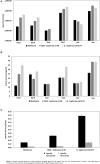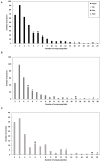Exploring the Molecular Machinery of Denitrification in Haloferax mediterranei Through Proteomics
- PMID: 33363526
- PMCID: PMC7754194
- DOI: 10.3389/fmicb.2020.605859
Exploring the Molecular Machinery of Denitrification in Haloferax mediterranei Through Proteomics
Abstract
Many proteins and enzymes involved in denitrification in haloarchaea can be inferred to be located between the cytoplasmic membrane and the S-layer, based on the presence of a Tat signal sequence and the orientation of the active site that some of these enzymes have. The membrane fraction of the haloarchaeon Haloferax mediterranei (R-4), grown under anaerobic conditions in the presence of nitrate, was solubilized to identify the respiratory proteins associated or anchored to it. Using Triton X-100, CHAPS, and n-Octyl-β-d-glucopyranoside at different concentrations we found the best conditions for isolating membrane proteins in micelles, in which enzymatic activity and stability were maintained. Then, they were subjected to purification using two chromatographic steps followed by the analysis of the eluents by NANO-ESI Chip-HPLC-MS/MS. The results showed that the four main enzymes of denitrification (nitrate, nitrite, nitric oxide, and nitrous oxide reductases) in H. mediterranei were identified and they were co-purified thanks to the micelles made with Triton X-100 (20% w/v for membrane solubilisation and 0.2% w/v in the buffers used during purification). In addition, several accessory proteins involved in electron transfer processes during anaerobic respiration as well as proteins supporting ATP synthesis, redox balancing and oxygen sensing were detected. This is the first characterization of anaerobic membrane proteome of haloarchaea under denitrifying conditions using liquid chromatography-mass spectrometry. It provides new information for a better understanding of the anaerobic respiration in haloarchaea.
Keywords: Haloferax; anaerobiosis; denitrification; detergents; electron transfer; haloarchaea; liquid chromatography-mass spectrometry; proteomics.
Copyright © 2020 Torregrosa-Crespo, Pire, Richardson and Martínez-Espinosa.
Conflict of interest statement
The authors declare that the research was conducted in the absence of any commercial or financial relationships that could be construed as a potential conflict of interest.
Figures



Similar articles
-
Haloferax mediterranei, an Archaeal Model for Denitrification in Saline Systems, Characterized Through Integrated Physiological and Transcriptional Analyses.Front Microbiol. 2020 Apr 22;11:768. doi: 10.3389/fmicb.2020.00768. eCollection 2020. Front Microbiol. 2020. PMID: 32390995 Free PMC article.
-
Characterisation of chlorate reduction in the haloarchaeon Haloferax mediterranei.Biochim Biophys Acta. 2015 Apr;1850(4):587-94. doi: 10.1016/j.bbagen.2014.12.011. Epub 2014 Dec 13. Biochim Biophys Acta. 2015. PMID: 25512066
-
Nitrate-Responsive Suppression of Dimethyl Sulfoxide Respiration in a Facultative Anaerobic Haloarchaeon, Haloferax volcanii.J Bacteriol. 2021 May 20;203(12):e0065520. doi: 10.1128/JB.00655-20. Epub 2021 Apr 5. J Bacteriol. 2021. PMID: 33820797 Free PMC article.
-
Anaerobic Metabolism in Haloferax Genus: Denitrification as Case of Study.Adv Microb Physiol. 2016;68:41-85. doi: 10.1016/bs.ampbs.2016.02.001. Epub 2016 Mar 15. Adv Microb Physiol. 2016. PMID: 27134021 Review.
-
Metabolic regulation including anaerobic metabolism in Paracoccus denitrificans.J Bioenerg Biomembr. 1991 Apr;23(2):163-85. doi: 10.1007/BF00762216. J Bioenerg Biomembr. 1991. PMID: 2050653 Review.
Cited by
-
Elucidating metabolic pathways through genomic analysis in highly heavy metal-resistant Halobacterium salinarum strains.Heliyon. 2024 Nov 30;10(23):e40822. doi: 10.1016/j.heliyon.2024.e40822. eCollection 2024 Dec 15. Heliyon. 2024. PMID: 39717611 Free PMC article.
-
Transcriptomic profiling of haloarchaeal denitrification through RNA-Seq analysis.Appl Environ Microbiol. 2024 Jun 18;90(6):e0057124. doi: 10.1128/aem.00571-24. Epub 2024 May 30. Appl Environ Microbiol. 2024. PMID: 38814058 Free PMC article.
-
Denitrification in hypersaline and coastal environments.FEMS Microbiol Lett. 2023 Jan 17;370:fnad066. doi: 10.1093/femsle/fnad066. FEMS Microbiol Lett. 2023. PMID: 37422443 Free PMC article.
-
Assessment of Haloferax mediterranei Genome in Search of Copper-Molecular Machinery With Potential Applications for Bioremediation.Front Microbiol. 2022 Jun 15;13:895296. doi: 10.3389/fmicb.2022.895296. eCollection 2022. Front Microbiol. 2022. PMID: 35783429 Free PMC article.
-
High variability of perezone content in rhizomes of Acourtia cordata wild plants, environmental factors related, and proteomic analysis.PeerJ. 2023 Nov 15;11:e16136. doi: 10.7717/peerj.16136. eCollection 2023. PeerJ. 2023. PMID: 38025722 Free PMC article.
References
LinkOut - more resources
Full Text Sources

